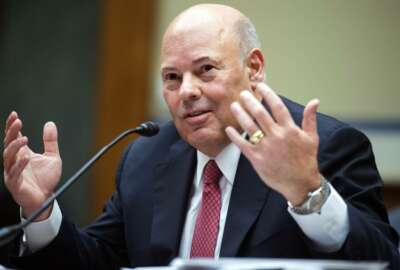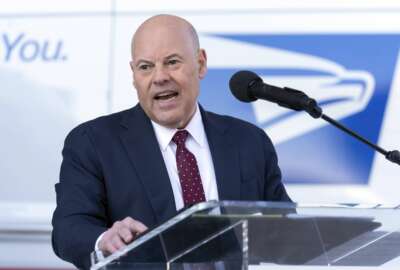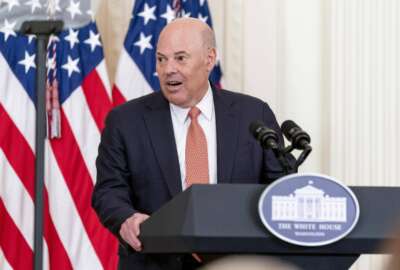Exclusive
DeJoy says USPS needs to get ‘better faster’ under reform plan, or risk running out of cash
Pouring over presentation slides in a conference room at USPS headquarters, DeJoy goes into detail about the investments USPS is making to exponentially increase...
The future of the Postal Service depends on packages, according to its Postmaster General Louis DeJoy — a lot of them.
A key tenet of his 10-year Delivering for America Plan, now in its third year, is to capture a bigger piece of the package business from private-sector companies like UPS, FedEx and Amazon.
Pouring over presentation slides in a conference room at USPS headquarters, DeJoy goes into detail about the investments USPS is making to exponentially increase its capacity to process and ship packages.
It’s a safe bet, DeJoy says, since USPS goes where its competitors don’t — to more than 165 million addresses, at least six days a week. Letter carriers are going there anyway, so why not fill the empty space on their trucks with packages that will help the agency pay its bills?
But the stakes of this bet are nothing less than the ability of USPS to keep its lights on, the same way it has for more than 50 years.
“Our competitors are reacting to us out there, and we will get better faster,” DeJoy told Federal News Network in a recent interview. “I’m very confident in that — that we’ll get better faster. My issue right now is to get it done fast enough, before we run out of cash.”
USPS, according to the most recent Treasury Department data, had $17.4 billion cash on hand at end of January.
To recover from its long-term financial challenges, DeJoy told congressional leaders last month that USPS is looking to cut $5 billion from its operating costs and grow its revenue by the same amount over the next two years to overcome its long-term financial challenges.
DeJoy said USPS hopes to reach that goal, in part, by delivering more packages and reducing the cost of delivering them. All of this, he adds, is about cracking down on inefficient practices at an agency that has been slow to evolve with the age of e-commerce.
“We have administratively begun to bear down on wasteful practices,” DeJoy said. You don’t want empty trucks all over the place. You don’t fly stuff that you can get there by ground.”
USPS, so far, has saved about $1 billion annually by shifting more than 85% of mail and package volume that it used to pay contractors to fly across the country. Now the agency delivers that volume on its ground transportation network of trucks.
Even with this plan in place, USPS faces an uphill battle to dig out from more than 15 years of net losses. It ended fiscal 2023 with a $6.5 billion net loss, and expects to end this year with a similar net loss — falling short of its break-even goal.
“We fumbled a couple of things in a couple of areas, which is unfortunate. So, the journey is longer than I wanted it to be,” DeJoy said. “Our problems are bigger, and more programmed into our systems on how we do things. So, it’s taking time. We’ve had a lot of adverse headwinds, but man oh man, we’ve gotten a lot done.”
Amid that red ink, DeJoy points to bright spots that USPS is turning things around.
USPS saw $21.6 billion in total revenue in the first quarter of FY 2024 — a 0.5% increase compared to the same period the year prior.
It also saw a $240 million, or 2.7%, increase in package revenue in the first quarter, and delivered 98 million more packages —a 5.1% increase — compared to the same quarter last year.
DeJoy said in a video message to USPS employees last month that “this shows that we are winning new customers, winning more volume from existing customers and reclaiming market share in the package business that we surrendered long ago.
It’s progress, but DeJoy says USPS is making up for lost time and decisions its leadership team, Congress and its regulator, the Postal Regulatory Commission, should have made more than a decade ago.
“We have violated the law. For the last 15 years, the law was to break even. In order to do that, you have to evolve your service … That’s what we’re in the process of doing,” DeJoy said.
“It should have been us 15 years ago. We had this in the bag, and we blew it,” he added.
DeJoy and USPS executives attribute last year’s net loss to costs beyond the agency’s control — chief among them, higher inflation and contributions to the Civil Service Retirement System. If not for those costs, they say the agency’s break-even goals were within reach.
Growing the package business
USPS is making $40 billion in capital investments under its reform plan. Much of the investment is going into its network of facilities that account for $20 billion in deferred maintenance.
Zooming in on a Sorting and Delivery Center (S&DC) in Atlanta, DeJoy says the plant’s biggest package sorting machine, prior to the reform plan’s investments, could handle 6,000-8,000 packages in an hour, at a maximum.
“And it would struggle. It was smoking,” he said.
With recent upgrades, DeJoy said that package sorting machines at the Atlanta facility can now process 60,000 packages an hour.
The agency is operating at a different pace than when he took office in the summer of 2020.
USPS during his tenure has purchased close to 450 package sorting machines as part of its capital improvements. Before his arrival, DeJoy said USPS was handling 25 million packages a day, by hand.
DeJoy says he’s confident increased capacity will translate into more volume. USPS, he adds, only accounts for 5% of the “middle market” package business, and that the agency must compete for a bigger piece of the pie.
“That’s embarrassing for the United States Postal Service. We need to get more of the middle market, and we’re going to do it,” he said.
Part of the problem, according to DeJoy, is that USPS has institutional expertise delivering mail and “flats” such as magazines, newspapers and catalogs, but doesn’t yet have the same operational precision when it comes to package delivery.
“When you look at mail processing, the Postal Service is awesome,” he said. “It moves. You go look at how we do packages, we’re in five different buildings at the same time. We’re doing it because we never geared up to do it the right way.”
USPS, he told the Board of Governors last week, is planning to roll out same-day and next-day shipping offerings “in the near future that will change the way you look at delivery and the way you look at the United States Postal Service.”
“We’re an organization of the people, for the people. We didn’t have products for the small businessperson. We didn’t have products for the medium businessperson. Now we’re going to start having it, as a growth area. We’re going to go after it,” DeJoy said.
While USPS sees growth opportunities for its package business, the agency expects declines in mail volume will continue.
DeJoy, in a December 2023 letter, told lawmakers total mail volume fell by 42% between 2007 and 2020. Total mail revenue during that same period fell from $60.6 billion in 2007 to $38.7 in 2020 —a 36% drop.
“We think we’re a mail monopoly, right? We’re not. We’ve got $39-40 billion worth of mail that costs us $60-70 billion to deliver,” he said in the interview That’s not a monopoly, that’s an obligation.”
Eliminating ‘waste’ in the USPS network
To grow its revenue and reduce its operating costs, DeJoy said USPS is managing the biggest shakeup of its delivery network in the agency’s history.
That network modernization, once finalized, will bring mail and packages through 60 regional processing and distribution centers, 190 Local Processing Centers, 600 Sorting and Delivery Centers and 15,000 “delivery units,” mostly post offices.
“This is by no means a consolidation of good stuff. This is a rearrangement of the furniture. I imagine we’ll come out with more square footage deployed around the nation than before we started. It’s just not going to be wasteful square footage,” DeJoy said. “I’m talking about waste, and handling things 17 times, instead of handling it once or twice — because it’s doable. That’s what the other guys do. We have to cover a lot of infrastructure. That drives a lot of our cost, the plant is the footprint that we have. So, I don’t see that changing, really.”
Looking ahead, DeJoy said USPS is looking to open Sorting & Delivery Centers across the country later this year. S&DCs are large facilities that consolidate the operations of letter carriers and mail handlers under one roof.
DeJoy says the new facilities are an upgrade for USPS employees who previously worked in old, dark facilities that were a drain on workforce morale.
While lawmakers and postal unions remain wary of the network shakeup, DeJoy said the upshot of this transformation is that some employees moving into S&DCs may see a longer commute.
“If there’s an uncomfortable expectation, it’s that. And how uncomfortable is that — you’ve got to go an extra 30 minutes to go to work? We have to get new plants, we have to improve our plants, we have to align our work, so we can move it efficiently,” DeJoy said.
He added: “When you say cost-cutting, I don’t even think of it that way. Because I’m looking at us trying to operate better. We’re still not making our service standards, and I know we can. So if we get our throughput up in a facility, and get our trucks to run on time, there’s a big chance that we can take a day’s work out of everything. Well, that adds up, and it doesn’t mean you’re changing people and stuff like that.”
‘More volume with the same people’
USPS in the first quarter of FY 2024 delivered a higher volume of packages while cutting 8 million work hours — one of the agency’s largest quarterly reductions in work hours in the last decade.
DeJoy said that translates into getting more productivity out of the workforce it already has — and relying more on its career workforce.
“[It’s] more volume with the same people,” DeJoy said. “That’s the positive thing about me. It’s about growing the organization and doing things right. I’ve got other things to do — I didn’t come here to cut people, it’s just ludicrous. There are days I feel like I’m in the Twilight Zone with some of the stuff I hear.”
If there’s anywhere to cut labor costs, DeJoy says it’s reducing workers’ compensation when employees get hurt on the job and overtime.
“I’m here like, ‘Hey everybody, let’s just get better, because we have to compete with the other guys. We’ve got a bazillion hours of overtime. Let’s do it with half a bazillion,” DeJoy said.
DeJoy told the USPS Board of Governors that the agency during the peak season “took necessary operating risks to deliver an increased volume while incurring less costs,” such as minimizing peak season staffing.
USPS only hired 10,000 seasonal employees nationwide for the recent peak season. The agency started to significantly taper its seasonal hiring in 2022, when it brought 20,000 temporary hires on board. Only a few years ago, USPS would hire up to 40,000 temporary employees for its peak season.
“Who did that effect that was working here? Nobody. Actually, it probably made their day a little better, because we didn’t have a whole bunch of new people running into plans that didn’t know what they were doing and so forth.”
The agency, however, grew its career workforce to 529,000 employees in December 2023. That’s an increase of 11,500 employees, a more than 2% growth in its career ranks, compared to 2022.
Since January 2021, USPS has converted 150,000 employees from pre-career to career status, with better wages and benefits. The agency sees a much lower rate of turnover for its career workforce.
USPS is trying to rein in turnover among its pre-career workforce, but even in a best-case scenario, DeJoy estimates pre-career turnover will still hover around 20%.
‘Half-bat, half-geese’
Among the slide decks he’s shown in meetings, DeJoy has presented mailing industry partners and lawmakers with a couple of analogies for the direction USPS is going.
When he started as postmaster general, DeJoy has said USPS functioned like a group of bats, flying erratically. The goal — and the vision for USPS — is to have the agency working in sync, moving in the same direction, like a flock of geese, flying in a “V” pattern.
“Right now, we’re half-bat, half-geese,” DeJoy said. “The way I look at it, half of us are flying in a V formation. It’s not that people are working against us internally — there’s nobody working against us. It’s trying to get people to work in a different way, and see things in a different way.”
“It’s taken a number of years and constant evolution,” but DeJoy said the USPS Board of Governors and its executive leadership team understand what it’ll take USPS to get back on track with its break-even goal.
The alternative, he said, USPS going from a self-funded agency to one that depends on Congress for appropriations, as it did as the pre-1970 U.S. Post Office, is not an option.
“If I had a never-ending funding mechanism, like a lot of other agencies do, I might act differently. If I was a policy shop, I might act differently. I’m not —I’ve got to deliver mail and packages. That’s it — cost-effectively. I’ve got to earn my own money,” DeJoy said.
With all the moving pieces of the USPS overhaul, DeJoy concedes not everything in the 10-year plan goes according to plan. Mistakes happen, he says, but they’re addressed and corrected quickly.
DeJoy says moving fast and making changes, even with the occasional setback, is better than the “status quo” of an agency that loses money.
“The historical approach that relied solely on cost-cutting and managing decline proved penny-wise and pound-foolish,” DeJoy told congressional leaders in a letter at the end of last year.
USPS last quarter insourced its logistics work from third-party contractors at several Surface Transfer Centers. DeJoy said that brought 1,000 jobs into USPS that it previously contracted out, but not without some growing pains.
USPS at the height of its peak season last December had to shut down a Surface Transportation facility for about two weeks in Saint Louis, Missouri, because of a hazardous mercury leak from an illegally shipped package.
USPS delivered 85.9% of first-class mail on time in the first quarter of fiscal 2024.
DeJoy said at the last Board of Governors meeting that 98% of American households are getting their mail and packages within three days, but said “I do realize that individual communities do not view our performance at a national level,” he added, noting some delays at the local and regional level.
“There were mistakes and there were events, and there is positive action, and there are things that could go faster. I don’t run away from that,” DeJoy said. But this is about saving the Postal Service for the next 50, 60, 100 years.
“I’m into us being as self-contained as we possibly can, but we got to do it. We’ve got to do it like the other guys do, he added. “Which is really really good. Or we’ll be really, really gone.”
Copyright © 2025 Federal News Network. All rights reserved. This website is not intended for users located within the European Economic Area.
Jory Heckman is a reporter at Federal News Network covering U.S. Postal Service, IRS, big data and technology issues.
Follow @jheckmanWFED






